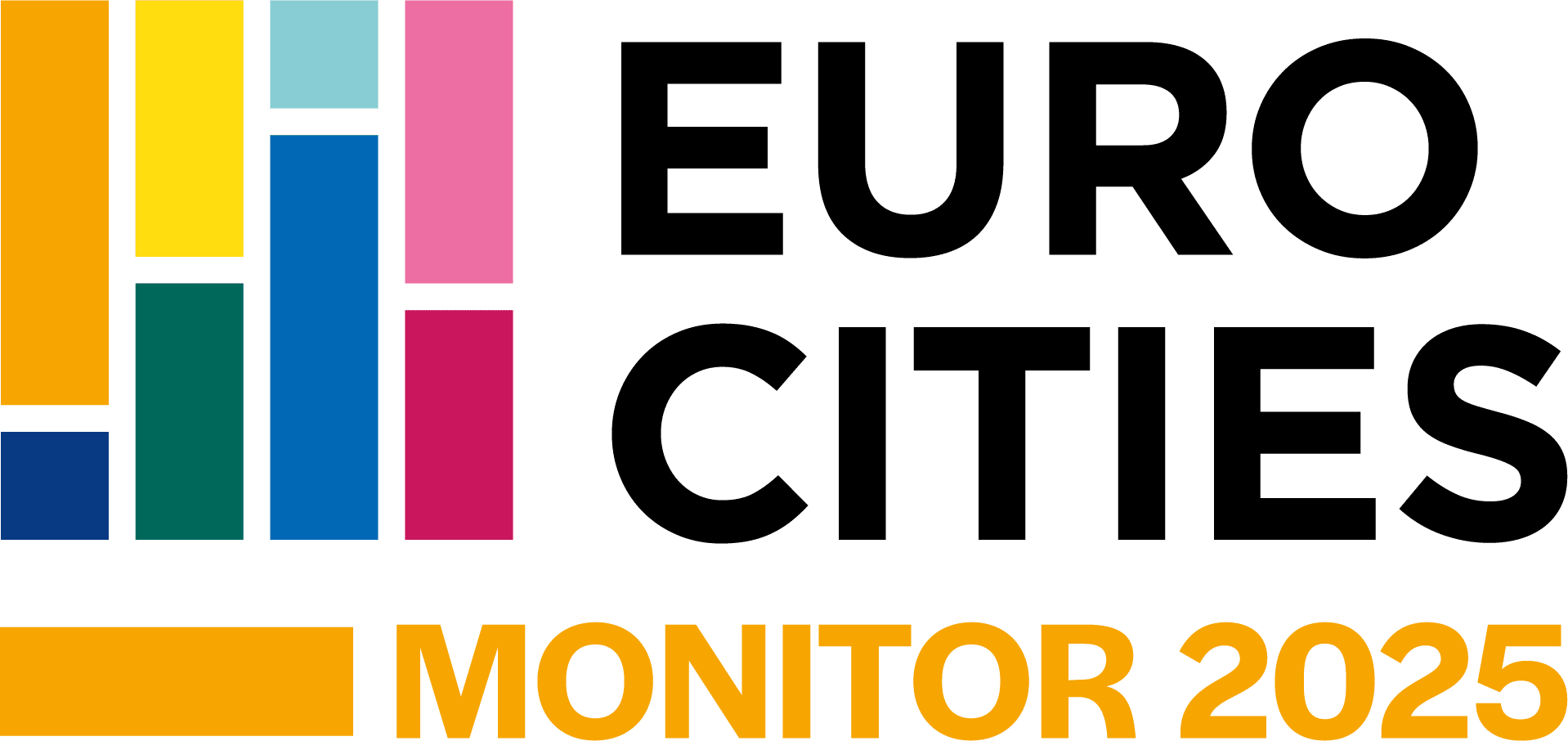The state of housing affordability in European cities

Europe’s housing crisis continues to deepen, with over one in three mayors (39%) now reporting that housing costs are unaffordable. For these cities, average incomes are no longer enough to cover sustainable rent (i.e. a rent that is approximately no more than a third of total income as defined by various EU countries) or mortgage payments, threatening social stability and pushing residents further from urban centres.
At the same time, only 14% of cities report that housing remains affordable for their residents. Just one in seven surveyed mayors say their cities offer accessible housing, with scores of seven or higher on the affordability scale. These cities include those that have managed to maintain affordability through strong public housing policies, controlled rent increases, or sustained investment in social housing.
For around half of European cities – 47% – housing affordability remains in a ‘moderate’ category, meaning it is not yet an acute crisis but remains a growing concern. These cities, including many in Central and Northern Europe, are at risk of slipping into unaffordability if housing prices and rental costs continue to outpace income growth.
The crisis is most severe in Southern and Western European cities, where affordability pressures are mounting at an alarming rate. Barcelona, which reported the most unaffordable housing market, reports the worst affordability crisis, reflecting Spain’s broader housing emergency, where high demand, speculative real estate, and limited new housing supply are pushing prices beyond reach.
Other major metropolitan areas – including Amsterdam and Zurich – scored three or below, firmly placing them in the ‘unaffordable’ category. Italian cities, including Florence, Rome, and Bologna; and French urban hubs such as Lyon, Nice, and Marseille, are struggling to keep housing costs under control, particularly as rising mortgage rates and short-term rental platforms accelerate housing shortages.
In Nordic and Central European cities, housing affordability trends are more mixed, but growing pressure is evident. Vienna stands out as Europe’s most affordable city, largely due to its long-standing commitment to public and social housing. Many Nordic cities, including Tampere, Malmo, and Vantaa, fall within the ‘moderate’ category, scoring between four and six, reflecting an increasing gap between wages and housing costs. Meanwhile, some mid-sized Polish and German cities, such as Chemnitz, Katowice, and Dortmund, report relatively better affordability than larger urban centres, though they remain cautious about future market trends.
Housing affordability in European cities
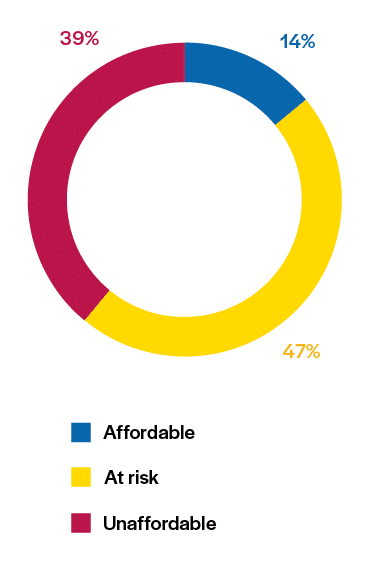

The survey paints a worrying picture of housing affordability across Europe. Rising interest rates, rental shortages, and gentrification pressures are worsening the crisis. Without urgent interventions, the affordability gap could force residents out of city centres, deepen social inequalities, and weaken the social fabric of Europe’s urban communities. This could have dangerous effects on the social diversity of cities and potentially lead to increased social segregation in cities.
Drivers of housing unaffordability according to mayors
Housing affordability is reaching a breaking point in many European cities, with mayors identifying key factors driving up prices and making it harder for residents to find affordable homes. The data reveals that while demand exceeding supply is the most widespread challenge, other pressures – including rising construction costs, limited land availability, speculative investment, and the expansion of short-term rentals – are compounding the crisis.
For seven in ten mayors, the biggest housing challenge is that too many people are chasing too few homes. More than 70% of cities (76%) rank demand exceeding supply as one of their top three concerns, making it the most frequently cited driver of unaffordability. In cities experiencing strong economic growth or rapid population increases, the pace of making housing available – whether by building new homes, repurposing vacant buildings, or bringing underutilised housing stock back onto the market – is not fast enough to keep up with demand.
Even when cities expand housing availability, rising costs make homes unaffordable for the people who need them most. Rising construction costs rank as the second most commonly cited driver, with 71% of cities flagging it as a major barrier to affordability. Inflation, labour shortages, supply chain disruptions, and rising land values are making it more expensive to develop housing at accessible price points. As costs escalate, developers increasingly prioritise high-end housing, leaving a widening gap for middle- and lower-income residents. Cities such as Zagreb and Malmo explicitly highlight the challenge of providing affordable housing when the cost of materials, wages, and land is rising faster than household incomes.
More than one in two mayors warn that land shortages are worsening the housing crisis. Limited land availability is a significant issue for 60% of surveyed cities, particularly those with strict zoning laws, protected historic areas, or geographical constraints. While land constraints present real barriers, some cities are exploring alternative strategies such as densification, mixed-use developments, and converting vacant commercial spaces into residential housing.
Key drivers of housing unaffordability
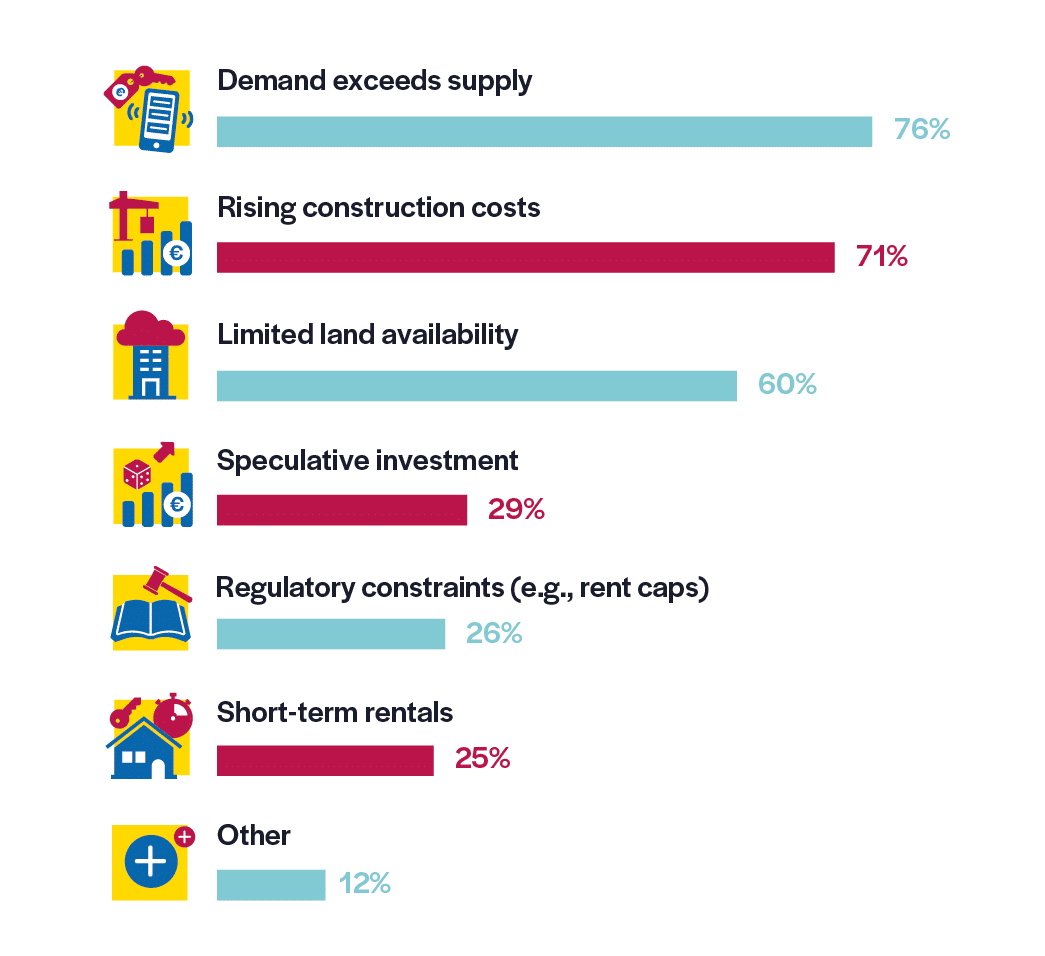

Real estate speculation is pricing out locals in key markets, particularly in high-demand areas. While not a universal issue, 29% percent of cities ranked speculative investment as a top-three concern. Cities such as Antwerp report that speculative investment plays a notable role in shaping their rental markets, as properties are increasingly bought as financial assets rather than homes. Zagreb highlights how financial incentives have unintentionally fuelled price increases, making it harder for residents to find affordable housing.
Regulatory constraints, such as rent caps and zoning laws, are considered important but not necessarily the root cause of unaffordability. Only 26% of cities rank regulatory factors among their top three concerns, suggesting that while policies like rent controls and zoning restrictions influence affordability, they are not the primary drivers of the crisis. Some cities, such as Gothenburg, argue that planning laws – rather than rent caps – are more significant obstacles to making housing available at affordable prices. Others point to national social policies, such as housing allowances and unemployment benefits, as additional factors shaping affordability.
For many tourist hotspots, homes are turning into hotels – pushing locals out of the market. Short-term rentals, particularly through online platforms, have become a serious concern in 25% of cities, particularly those with strong tourism demand. Cities such as Barcelona, Rome, Athens, and Budapest are among those most affected, as long-term rental stock is being converted into short-term lets, reducing availability for residents and driving up rents. Mayors in these cities see unregulated short-term rentals to be a major barrier to affordability and are calling for stricter national regulations.
Beyond these structural drivers, some cities face unique pressures that are accelerating housing unaffordability. In Varna, a 20% population increase driven by the arrival of Ukrainian refugees has intensified housing shortages. In Hatay, thousands of homes were destroyed by an earthquake, drastically reducing supply.
Delivering affordable housing in Europe’s cities: working towards the European Affordable Housing Plan
Housing is not just a basic need – it is a fundamental right. In her statement at the European Parliament to present her Political Guidelines 2024-29, President von der Leyen stressed that “Europe faces a housing crisis, with people of all ages and families of all sizes affected. Prices and rents are soaring. People are struggling to find affordable homes. […] Typically, housing is not seen as a European issue. Some might say we should not get involved. But I want this Commission to support people where it matters the most. If it matters to Europeans, it matters to Europe.”
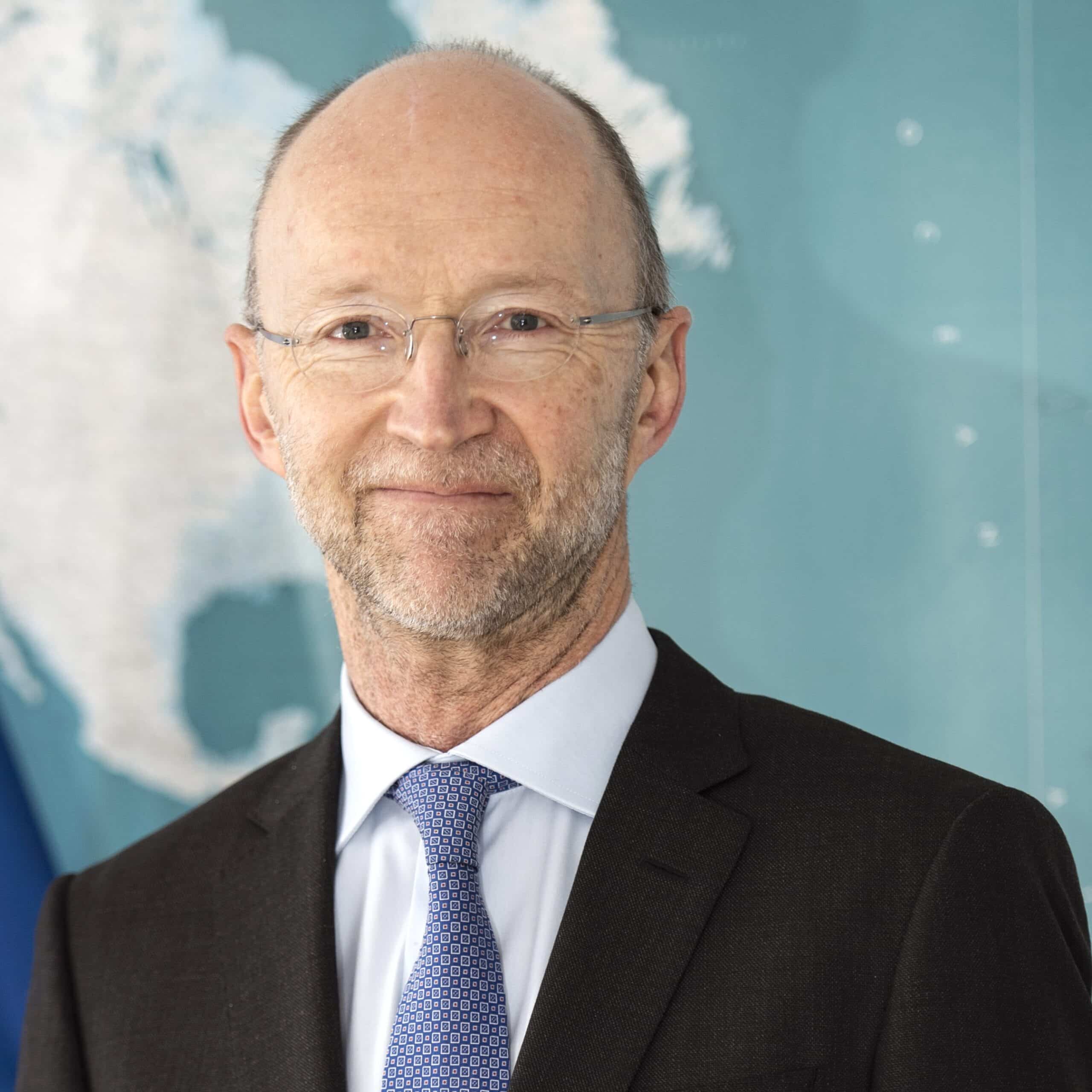
By Matthew Baldwin
So, for the first time, the European Commission has appointed a Commissioner in charge of housing, Dan Jørgensen, to address Europe’s housing crisis, and we have set up a task force to coordinate work across the Commission. The European Parliament has also established a Special Committee on the Housing Crisis.
As this survey confirms, cities face a serious affordable housing challenge. Young people and families are encountering real problems in securing affordable housing in our major cities. We are seeing an increase in homelessness, affecting more than one million people, including 400,000 children, so the most vulnerable in society are as ever in the front line. But the crisis is also impacting middle-income households, people in steady jobs, and key workers like teachers, nurses and police officers who cannot afford to live in the cities they serve. There are concerns that short-term rentals in cities like Barcelona, Rome, and Paris may be driving up prices and reducing the chances of local people to find affordable homes.
This crisis is causing not just social exclusion but also, by restricting labour mobility, risks damaging our competitiveness and even our demography as young people are delaying starting a family. However, cities are set to play a major role in finding a response. The Commission takes careful note of the proposals of the group of European Mayors for Housing presented in February 2025 and looks forward to the final opinion on the role of cities and regions that is being drafted by the mayor of Barcelona for the European Committee of Regions. The affordable housing crisis also, of course, affects smaller cities and the Commission also recognises the housing problems in rural areas faced with depopulation, poor infrastructure and a lack of job opportunities.
To prepare to respond to these challenges, the European Commission has launched a major consultation exercise ahead of the adoption of the European Affordable Housing Plan in 2026. We want to hear from all stakeholders right across Europe. We are launching a Call for Evidence, and the full public consultation will involve a series of themed consultation events.
The Plan itself will focus on funding and financing, aiming to mobilise public and private investment through a pan-European investment platform as well as putting more cohesion funds into housing, and reviewing state aid rules. We will address the inefficient use of the current housing stock and examine the potential role of housing speculation and financialisation. We will also deliver a European Strategy on Housing Construction and take a careful look at potential obstacles to new building, renovation, and repurposing, such as zoning and permitting rules. Additionally, we will support you in implementing the new Regulation on short-term accommodation rental services, which will equip you with the necessary data to adopt proportionate and justified measures when necessary.
Perhaps most of all, by bringing member states, regions and cities together, we see massive scope for mutual learning and sharing of best practices on how to deliver affordable, sustainable, and decent housing in Europe.
Speaking at the launch of our public consultation on 24 March, Commissioner Dan Jørgensen stressed the need to see affordable housing in a broader social context, calling for investment in “decent, accessible and durable houses, well connected to local infrastructure – for health and education, services and resources – which provide the building blocks of communities, and the foundations of society.”
Cities understand very well the importance of affordable housing in this sense and will play a key role in overcoming the crisis. Your voice will be particularly important in this process. I would like to take this opportunity to encourage you to take a very active role in the consultation process this year and bring us your ideas!

By Matthew Baldwin
Housing development priorities
European mayors are making affordable and social housing their top priorities as the housing crisis deepens across the continent. Almost one in two cities (47%) identified increasing the supply of affordable housing to be their most important priority, and an overwhelming 93% placed it among their top three. The urgency of tackling affordability is shared by cities across all regions, from major urban centres such as Milan, Lisbon, and Amsterdam to mid-sized cities like Braga, Poznan, and Cluj-Napoca. These cities emphasise that demand continues to outstrip supply, and without large-scale interventions, housing costs will remain out of reach for a growing share of residents. Some cities are going beyond supply-side solutions and cracking down on speculative real estate practices, while others are targeting vacant investment properties to free up more housing for residents.
Alongside affordability, expanding social housing is a major focus, with 32% of cities ranking it as their top priority and a striking 76% placing it in their top three. Many cities, particularly in Central and Eastern Europe, are working to expand their historically limited public housing stock to counterbalance market-driven price increases. Other actions include leading large-scale social housing investment programmes or focusing on repurposing underused properties for social housing instead of relying solely on new developments. In cities like Rome, the emphasis is on reintroducing social housing policies that had been scaled back over the past decade, recognising the critical role public intervention plays in stabilising housing markets.
Ranking of housing priorities in European cities
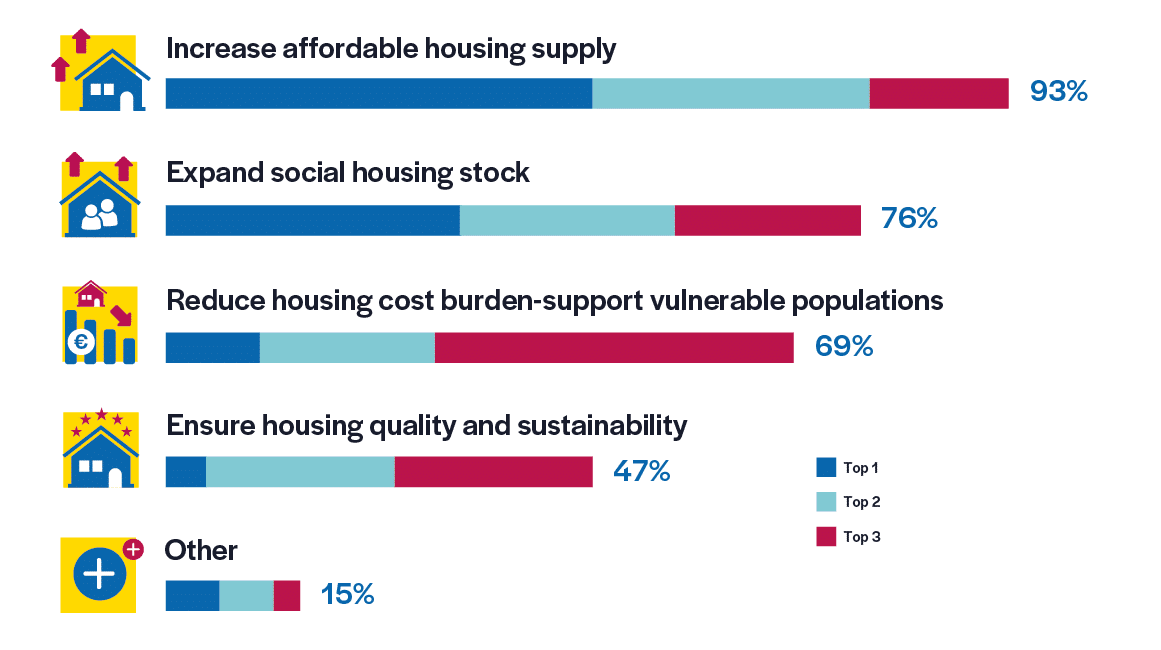

While supply-side solutions dominate, cities are also grappling with how to protect vulnerable populations from the immediate impacts of the affordability crisis. Reducing housing cost burdens for vulnerable groups was the top priority for 10% of cities, while more than 69% placed it among their top three. This is particularly important in cities with high rental pressures, where authorities are implementing targeted financial assistance and rent control measures to prevent displacement.
The quality and sustainability of housing, particularly for elderly and low-income residents, is another key issue. This reflects a growing recognition that affordability cannot be addressed by simply building more homes – existing housing stock must also be improved. Some cities are focusing on large-scale renovations to enhance energy efficiency and reduce long-term costs for residents. Others are investing in accessible housing that meets the needs of ageing populations, ensuring that cities remain inclusive as demographic trends shift.
Beyond these four main policy priorities, some cities are tackling distinct local challenges. Barcelona has announced a ban on short-term rentals by 2028, aiming to rebalance its housing market in favour of long-term residents. Malaga and Madrid are focusing on expanding affordable rental housing for young workers to counteract talent flight due to high housing costs. Antwerp and Ghent are shifting attention towards renovation rather than new construction, arguing that repurposing existing buildings can increase supply more quickly and efficiently.
EU financing for social and affordable housing
European mayors are calling for stronger EU support to address the housing crisis, with a clear preference for direct EU funding, greater flexibility in national housing investments, and improved access to affordable financing. While financial resources are a crucial part of the solution, mayors also stress that investment must be paired with ambitious local policies and innovative projects to have a lasting impact.
The strongest demand from mayors is for direct EU budget resources, with 56% ranking it as their top priority. The expectation is that EU funding mechanisms, such as Cohesion Policy and dedicated housing programmes, should be more accessible to cities to support large-scale investment in affordable and social housing. Currently, most cities struggle to leverage EU funding for new housing projects, and the few other EU resources available are not directly reaching out to local governments.
Ranking of priorities for EU financing for social and affordable housing
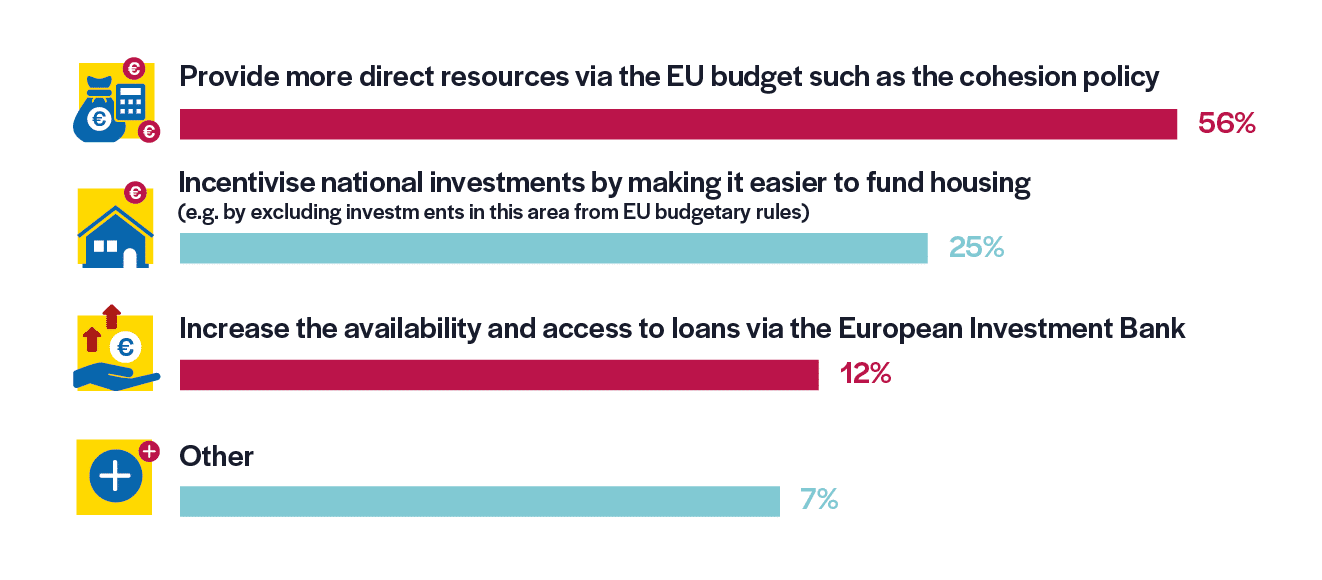
Mayors are also pushing for greater flexibility in national housing investments, with 25% prioritising EU incentives to ease budgetary constraints on housing-related spending. Many cities express frustration with restrictive fiscal rules that limit public investment in housing, arguing that such constraints undermine efforts to expand affordable housing stock. Many advocate for reforms that would allow national governments to prioritise housing development without being penalised for increasing public expenditure. Some cities go further, arguing that housing should be treated as a social investment rather than a financial burden under EU fiscal rules.
Access to European Investment Bank (EIB) loans is viewed by many mayors as a valuable tool – if adapted to better meet cities’ needs. Antwerp, for example, has emphasised that EIB loans should offer lower interest rates than what the market offers and be more accessible for non-speculative housing projects, such as cooperative housing and urban renewal schemes. Other cities stress that while loans can be useful, they are not a substitute for direct grants, particularly given the restrictions for many cities to use debt-financing for such investments, often due to national rules aimed at respecting EU fiscal rules.
Beyond financial tools, some mayors are calling for the EU to play a stronger role in regulating housing markets. Malmo, for example, argued that the EU could do more to curb housing speculation and ensure that housing is treated as a social right rather than a financial commodity.
The message from mayors is clear: while local governments are at the forefront of delivering solutions, they cannot tackle the housing crisis alone. More direct funding, greater flexibility in national investments, transparency in the housing market, and improved financing mechanisms are needed to empower cities to implement ambitious housing policies. Without stronger EU engagement, the gap between housing demand and supply will continue to grow, putting further pressure on affordability and social cohesion in European cities.
Mayors’ experience and expectations in accessing EU funding
When asked about their experience and expectation in accessing EU funding for housing, most mayors stress that the existing system is difficult to navigate and does not meet the scale of the housing crisis.
Many mayors highlight the unpredictability and lack of clarity of EU funding streams, making it difficult to plan long-term investments. Munich warns that funding volumes are too low and quickly exhausted, while the framework conditions for accessing funds change too frequently. This lack of stability, according to Budapest, prevents cities from making the kind of multi-year investments needed to meaningfully expand housing supply. The city proposes a permanent EU governance mechanism to facilitate direct engagement between local governments and the EU institutions on housing finance, similar to the 100 Climate-Neutral & Smart Cities Mission.
Administrative complexity and bureaucratic burdens are among the most frequently cited obstacles. Nice stresses that the process for securing EU funds is too cumbersome and fragmented, preventing municipalities and social housing providers from accessing support efficiently. Several cities argue that without streamlined procedures, even well-funded EU initiatives will struggle to deliver results on the ground.
There is broad consensus among mayors that the role of Cohesion Policy in housing finance should be strengthened, with cities calling for long-term affordability to be explicitly recognised as a pillar of economic, social, and territorial cohesion.
Several mayors have concrete proposals for structural reforms to the EU’s financial approach to housing. Rennes, for example, proposed a dedicated financing mechanism that would fix interest rates for housing sector loans at 2%, ensuring stability regardless of economic fluctuations. Barcelona and Rome, part of the new Mayors Alliance for Housing, call for EU-backed housing programmes specifically aimed at middle- and low-income families who fall between the cracks of social housing eligibility and private rental affordability. Toulouse urges the EU to provide a clear mapping of funding opportunities, ensuring that cities can easily match their legal competences with available EU resources.
In the face of rising construction costs, growing demand, and an increasingly competitive rental market, mayors are making a clear case for stronger EU action. In line with the recent creation of the European Commission’s first ever Housing Task Force to support the delivery of the European Affordable Housing Plan, it is clear that the voices of mayors will need to play a key role in finding solutions that work for all Europeans.
